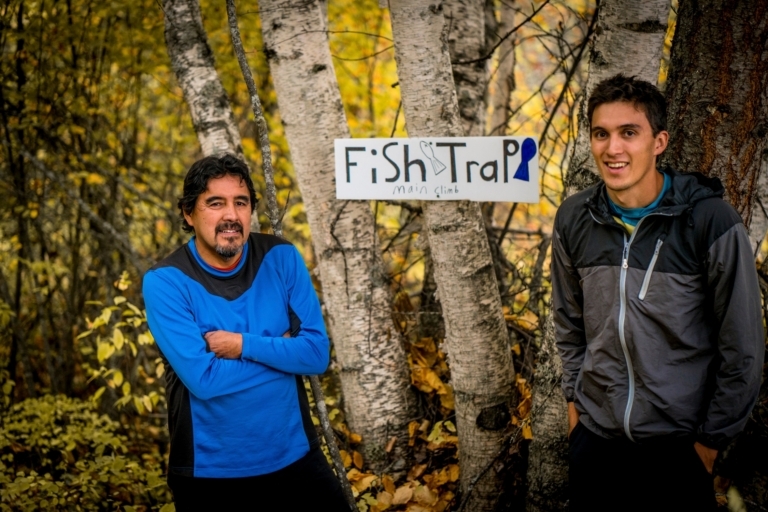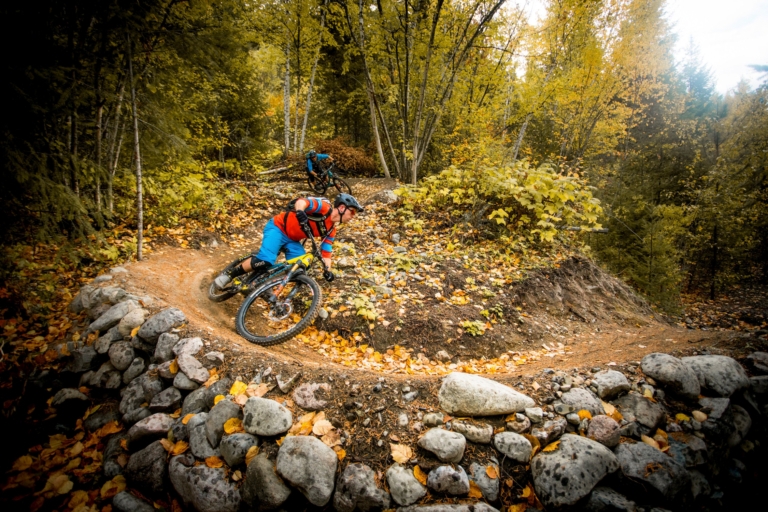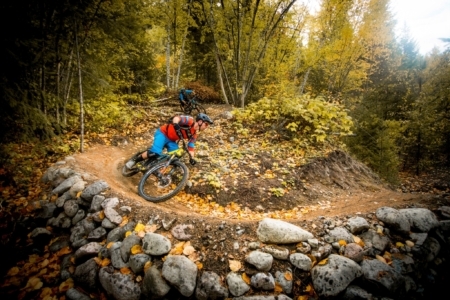The Myth of the Great Bike Savior
Outdoor recreation can be a lifeline for rural economies, but the industry has also benefited from the erasure of Indigenous peoples from their lands.
Light wisps of steam rose up from the mound of wet, loamy earth, and the scent of rotting biomass, birch needles and freshly baked mud tickled my nostrils. I pulled clumps of mud and sodden leaves from around a series of entangled tree roots, the gnarled limbs and knuckles of an old birch rising more than 100 feet above me. Dislodging bright brown and red mineral soils, I exposed a complex web of rhizomes mingling with fungi, each dependent on the other for critical nutrients. I marveled at the delicate balance.
“Hey, Seme7uy,” a voice called out behind me—my friend and mentor, Tom Eustache. “You’re supposed to be digging, not playing in the dirt.”
Tom is the Director of Public Works for the Simpcw First Nation, a people who have lived in the hills and valleys surrounding British Columbia’s North Thompson River for thousands of years. The day’s project was a fresh ribbon of singletrack snaking down a small mountain overlooking the river, and I wasn’t just playing. By digging out the roots, I hoped to get a better idea of their extent; with that knowledge, we could use rocks and dirt to build a ramp over the roots hidden underground and protect the tree and soil. It’d also make for a better ride.
Seme7uy—pronounced “sa-ma-oh-ee”—is a Secwepemctsin phrase that Tom and his nephew Leon started calling me after I came to work with the Simpcw Nation six years ago. I was excited about the name, seeing it as an indication that I had, perhaps, found my proper place in the community. Then I asked what it meant.
“Seme is our word for ‘white man,’” Tom explained. “Seme7uy means…”
“Really white,” Leon finished, no doubt a reference to my pasty white complexion, burned pink in the hazy summer sun. It was a subtle jab and a reminder of how I first came to be here: the crazy white guy who showed up one day, raving about bikes and trails and how I was going to save their people.
Several years earlier, I had created the Indigenous Youth Mountain Bike Program (IYMBP), a nonprofit organization with a simple goal: Get Indigenous youth on bikes, outdoors and living healthy, active lives. Riding bikes had always been a central part of my own life; it was how I found a sense of connection and belonging, made friends, built community. I wanted to share that passion and help a few kids along the way.
My true motivation went much deeper than that. For years, I had a growing sense that something was fundamentally wrong with my country and our relationship with Indigenous peoples. It wasn’t until I was in university that I started to learn the true extent of the duplicity and betrayal wrought upon the original peoples of the Americas: land clearances and theft, starvation and bioterrorism. The destruction of their language and culture. The systemic kidnapping of children forced into residential schools, stripped of their identities, and subject to mental, physical and sexual abuse.
Once I learned these truths, I could no longer turn away. I knew I had to do something. Unfortunately, my schooling did not provide any clue as to what that something should be. So, I turned to the one thing that has always sustained me: bikes.
For months I traveled all around the province, meeting with any First Nation that would grant me an audience. I hoped to find a community that would share my vision for creating a mountain bike Shangri-La, a place where people from all over the world could come together to build trails and share rides.
The reaction I received was not encouraging.
“Why would we want more outsiders on our lands?” an Elder asked me. “We use our trails for hunting, for gathering medicine, for our ceremonies and traditions. The land is our mother; it’s not for white people to play on.”
“Every time seme comes to our land, they always say they’re going to save us,” said another Elder. “But what they really want is to take or build: trees and resources, shipped out on roads, railways, pipelines and power lines. Now you want trails? How is that going to benefit our people?”
I didn’t have any answers.
I was ready to give up when a friend told me about Tom Eustache and the Simpcw Nation. “They’re a mountain bike nation,” he said in hushed tones, as though he were letting me in on a secret. “They have embraced trails and riding the same way their ancestors embraced horses more than 100 years ago. Everyone in the community rides. You have to see it for yourself.”
I was intrigued; perhaps this was the place I had been looking for, and I managed to connect with Tom and arrange a visit. He was kind enough to take me out for a ride. They had trails: tight, hardpacked game paths that weaved through dense stands of spruce, birch and hemlock. The trails were rough, reminding me of the steep fall lines I built with my friends as a teenager, but that just made them feel rawer and more authentic.
“When we’re not riding, we’re building,” Tom told me. “We’re out here every night after work and on the weekends.”

Tom Eustache and his son, Skylar Camille, pose on Fish Trap, a trail built by the Simpcw First Nation. Skylar is now a full-time trail builder for First Journey Trails. Photo: Robin Munshaw, courtesy of Mountain Biking BC
It wasn’t just Tom, either. Everyone was involved: elders, youth and leaders, all working together in the woods. This, I thought, was what I had been searching for—the place where I could make my mountain bike vision a reality.
Before I could launch into my usual sales pitch, outlining my plan for his people and his land, Tom interrupted me by placing a shovel in my hand. “No dig, no ride,” he said. “You want to play with us; first, you put in the work.”
Over the next several years, I built trail alongside Tom and the Simpcw community. We brought in professionals such as Thomas Schoen, an advocate and master builder from Williams Lake, British Columbia, and Mark Wood, formerly of the North Shore Mountain Bike Association. But the true work happened every time I returned to the Simpcw Nation, something I did as often as I could.
On each visit, I sat with Tom, his family and his people and listened to their stories. Tom shared how the Royal Canadian Mounted Police forced the Simpcw people to abandon their lands at gunpoint and walk nearly 200 miles by foot to the reserve; how governments and businesses stole their vast territories and plundered them for resources; and how their children were taken to residential schools, where they were forbidden to use their language and suffered terrible abuse.
Then Tom and Leon told me how mountain biking and adventure recreation are linked with this colonial legacy.
Throughout British Columbia and across Canada, recreation and adventure sports have supported and benefited from colonialism and the erasure of Indigenous peoples from the land. National parks, ski resorts, bike parks, golf courses, popular climbing areas and mountain bike trails have often been built on Indigenous lands, without consultation and against the wishes of local Indigenous Nations, undermining their rights and land claims. When Indigenous peoples have protested against these incursions, they have been attacked, arrested and imprisoned. Whenever the outdoor recreation community ignores these realities in pursuit of adventure, it becomes another obstacle Indigenous peoples must navigate to assert their rights and practice their culture and relationship with the land.
For Tom and the Simpcw people, the trails are about much more than recreation and fun. They are a symbol of how, as a people, they have endured and survived. How they never gave up and kept fighting to assert their rights and title and reclaim their creator-given role as the caretakers and stewards of their land. Tom and Leon are building trails and digging their people out from the shadow of 150 years of colonial genocide.
I realized that my approach to riding had become shallow and superficial, dominated by a selfish need to escape with no consideration of the impacts it would have on Indigenous peoples. My delusion as the Great Bike Savior was designed to absolve feelings of misplaced guilt and avoid addressing the underlying system of colonialism that supports the recreation sector.
Working with Tom allowed me to expose and examine these roots.
“It’s all about relations,” Tom told me as we dug alongside one another. “Everything we do—when we dig, ride, harvest plants or animals—we always take the time to stop and consider our relations: to the land, the animals, our people. When I get on my bike, that is what I’m thinking about. When all those things are cared for, I know I’m going to have an epic ride.”
When walking through a forest, it’s easy to focus solely on the grandeur of the trees. But it’s the unseen relationships, the webs of rhizomes and fungi, that allow the forest to thrive and flourish beyond what any one organism could achieve on its own. I’ve come to the conclusion that we, as a mountain bike community, have a choice: Do we want the sport we love, the trails we ride, to become a place of colonial erasure? Or do we want to be a part of something bigger, something that brings people together?
The Indigenous Youth Mountain Bike Program has evolved. We no longer view riding and trails as a means for “saving” Indigenous peoples; they know their needs and are actively working to create prosperity for their people and assert their rights and title to their lands and territories.
Instead, the program has become a means to realign IYMBP with their cause and to disrupt the colonial legacy of recreation and adventure sports. We work with First Nations at the direction of their Elders and hereditary chiefs. We train their youth to build trails that serve their needs and their people. We work with local mountain bike clubs to foster respect for Indigenous protocols and uphold Indigenous rights and title. We provide resources for trail clubs around the province to improve their relations and foster authentic reconciliation with Indigenous peoples.
Recently, we completed a document called “Working in a Good Way,” with recommendations and best practices for moving forward. Our advice to mountain bikers looking to ride on Indigenous lands: Research and educate yourself about our area’s history and the places we live and play on. Listen to Indigenous voices and communities, and uphold Indigenous rights and title. And, most importantly, when an Indigenous community says “no” to riding or building a trail and instead asks we stay out of an area for cultural or environmental reasons, accept it and support them in their efforts to protect the land. Their land.

Rides like Step It Up, a trail built by the Simpcw First Nation, draw people from across British Columbia—including Darren Butler, co-owner of a guiding company based in North Vancouver. Photo: Robin Munshaw, courtesy of Mountain Biking BC
Back on that ribbon of trail above the North Thompson River, Tom and I finished building the rock ramp over the birch tree roots. I stood up to admire our handiwork: a solid foundation and the tree and its roots fully protected. It wasn’t perfect, but far better for riding.
“Alright, seme7uy,” Tom said. “Good job!”
Leon appeared at my side, and we watched Tom making his way up the trail for a test run.
“It’s ‘Real White,’” Leon said. “Seme7uy means ‘Real White.’”
I stayed quiet, not sure I understood the difference.
Seeing my confusion, Leon continued. “When white men first came to our land, the fur traders initially seemed OK,” he said. “Strange perhaps, but not dangerous. All they seemed to care about was trading, getting furs. They didn’t interfere in our business; they were respectful, for the most part. Later, more white people came, but they were different. They interfered with everything, disrespected our ways, stole our land. Our people couldn’t understand why they were so different.
“We refer to those people who came before as the Real Whites. We always hope the seme can return to those ways.”
Leon paused as Tom dropped in. He hit the ramp, caught air and even managed a little tail whip before coming down on the path and skidding to a stop. “So much fun!” he yelled in triumph. “Seme7uy, you’ve got to ride this with me!”

